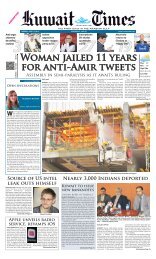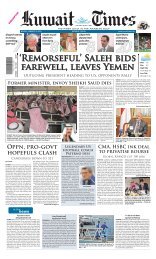KT 3-4-2013_Layout 1 - Kuwait Times
KT 3-4-2013_Layout 1 - Kuwait Times
KT 3-4-2013_Layout 1 - Kuwait Times
You also want an ePaper? Increase the reach of your titles
YUMPU automatically turns print PDFs into web optimized ePapers that Google loves.
Dar Al Shifa Hospital honors Professor Ahmed Noureddine<br />
KUWAIT: Dar Al Shifa Hospital recently<br />
held an honorary ceremony for Dr.<br />
Ahmed Adel Noureddine - Consultant<br />
Plastic Surgery, on his 50th visit to Dar<br />
Al Shifa hospital, as part of the hospital’s<br />
keenness on showing appreciation<br />
to the skills and expertise of its<br />
visiting doctors and strengthening<br />
relationships between the doctors and<br />
the hospital. This comes in line with<br />
Dar Al Shifa Hospital’s main objective<br />
of developing talents and expertise<br />
from around the world while also providing<br />
the latest medical technology<br />
and modern equipment to deliver<br />
best practice services to its patients.<br />
On this occasion, Dr Yousef Al<br />
Zafairy - Medical Advisor at Dar Al<br />
Shifa Hospital said: “We are proud of<br />
the collaboration we have with<br />
Professor Ahmed Adel Noureddine,<br />
given the depth of his medical expertise,<br />
commitment to the hospital<br />
through his 50 visits, and dedicating<br />
his services to our patients.”<br />
“Dr. Ahmed Adel Noureddine is<br />
well-known in his respective field and<br />
we extend our sincere appreciation to<br />
his remarkable medical achievements<br />
through the successful cosmetic and<br />
reconstructive surgeries he has performed<br />
at Dar Al Shifa Hospital,” added<br />
Dr Al Zafairy.<br />
The partnership between Dr Adel<br />
and the hospital reflects the hospital’s<br />
keenness to deliver the best optimum<br />
healthcare solutions through Dr. Adel’s<br />
skills and expertise in order to allow<br />
patients achieve their desired results.<br />
Dr. Ahmed Adel is the first Arab<br />
doctor to become the Diplomat of the<br />
American Board of Hair Restoration<br />
PRAGUE: Picture taken on May 5, 2012 shows Czech youth shouting slogans<br />
as they take part in a march calling for the legalization of marijuana, in<br />
Prague. Cannabis for therapeutic use has been legalised in Czech Republic<br />
from April 1, <strong>2013</strong>. —AFP<br />
Marijuana goes<br />
on sale in Czech<br />
PRAGUE: Medical marijuana legally went on<br />
sale yesterday in pharmacies across the Czech<br />
Republic for patients suffering from cancer,<br />
Parkinson’s disease, multiple sclerosis or psoriasis.<br />
The new law does not foresee health<br />
insurance coverage for marijuana, touted by<br />
some as a medical miracle drug.<br />
The prescription-only drug formally<br />
became legal on Monday, but was virtually<br />
unavailable as most pharmacies across the<br />
ex-communist European Union state of 10.5<br />
million were closed over to the Easter long<br />
weekend.<br />
Prague will first import the drug for about<br />
a year, reportedly from Israel or the<br />
Netherlands, until the State Institute for Drug<br />
Control starts issuing licences to local grow-<br />
NEWARK: New Jersey Governor Chris<br />
Christie signed a bill into law on Monday banning<br />
children under 17 from using commercial<br />
tanning beds, a move stemming from the<br />
case of a local woman accused of taking her<br />
5-year-old daughter into a tanning booth.<br />
Christie said that while he does not favor<br />
government regulation of small business, the<br />
new law was important for protecting the<br />
safety of minors. “Governmental regulation of<br />
the private sector should always be carefully<br />
scrutinized, and sparingly adopted,” he said in<br />
a statement. “The new restrictions imposed<br />
by this bill followed a single but breathlessly<br />
reported incident of a parent bringing a<br />
minor child into a tanning facility.”<br />
Patricia Krentcil of Nutley, New Jersey, was<br />
arrested in April 2012 after her daughter<br />
showed up at school with a sunburn and officials<br />
accused her of taking the child into a<br />
tanning booth.<br />
Krentcil, who became known in tabloid<br />
stories as the “Tan Mom,” testified that her<br />
ers for a maximum of five years.<br />
The institute will also determine the crop<br />
area and organise tenders for marijuana purchases<br />
from farmers. An EU member since in<br />
2004, the Czech Republic provides some of<br />
the most liberal access to soft drugs in<br />
Europe.<br />
People holding up to 15 grammes (0.53<br />
ounces) of marijuana or growing up to five<br />
plants of cannabis risk just a small fine-an<br />
approach that often attracts smokers from<br />
other countries such as neighbouring Poland,<br />
where tougher laws apply.<br />
A 2011 national report on narcotics said<br />
16.1 percent of Czechs aged 15-34 admitted<br />
to having used marijuana in that year, down<br />
from 20.3 percent a year earlier. — AFP<br />
Australia-led study in<br />
epilepsy breakthrough<br />
SYDNEY: An Australia-led study has identified a<br />
gene associated with a common form of epilepsy<br />
which could lead to earlier diagnosis, a<br />
researcher said yesterday.<br />
Melbourne University academic Ingrid<br />
Scheffer said a number of genes linked to<br />
epilepsy were known to scientists, but these<br />
related to rare families in which a large number<br />
of members had the condition.<br />
“The reason that this discovery is very important<br />
is that it’s not just for rare families, we think<br />
it will be a gene that will be important for people<br />
without a family history,” Scheffer told AFP.<br />
“So it’s changing the game in terms of being<br />
important for a much broader number of people<br />
with focal epilepsy.”<br />
Focal, or partial, seizures start in one part of<br />
the brain and affect the part of the body controlled<br />
by that part of the brain. Scheffer said a<br />
clinical diagnosis could not be made for epilepsy<br />
without seizures of some kind but the finding<br />
could aid genetic counselling and diagnosis-particularly<br />
in cases where everything else in the<br />
brain is normal.<br />
“When you have epilepsy people always say,<br />
‘Why have I got this?’ And this is the next level,<br />
which is the gene test,” she said. “So they will be<br />
able to be tested for this gene, and that’s important<br />
in terms of understanding the cause, in<br />
terms of treatment, and hopefully this will one<br />
day help outcomes.<br />
“And it’s also important in terms of genetic<br />
counselling for their own children,” she said,<br />
meaning people would be able to assess the risk<br />
for their own offspring if they were found to<br />
have the gene.<br />
The research comes after new gene detection<br />
techniques allowed scientists to pinpoint<br />
the abnormality, finding it in 12 percent of the<br />
80 families studied, in which one or more members<br />
had epilepsy. “That’s huge to find a gene<br />
that picks up 12 percent, 12 percent of the common<br />
cause of epilepsy,” Scheffer said.<br />
“I think that it means that if you look at anybody<br />
with focal epilepsy-without an abnormality<br />
on their MRIs, what we call a structural abnormality-my<br />
guess is that it will be 2-4 percent of<br />
them will have this cause.”<br />
The research, published in the April issue of<br />
the journal Nature Genetics, also involved scientists<br />
in Europe and Canada.<br />
Most of the families studied were Australian,<br />
but the group included some from Spain, Israel,<br />
Italy and elsewhere, Scheffer said. — AFP<br />
NJ bans children<br />
from tanning beds<br />
own chocolate-brown hue came from many<br />
hours spent under the intense ultraviolet<br />
light of a tanning bed or out in the sun soaking<br />
up rays.<br />
She denied exposing her daughter to a<br />
tanning session, and a grand jury opted not<br />
to indict her on charges of endangering the<br />
welfare of a child.<br />
New Jersey was already one of several<br />
states that have regulations prohibiting anyone<br />
age 14 or younger from tanning with<br />
commercial ultraviolet devices because of the<br />
risk of skin cancer. The new law extends that<br />
ban to older teenagers.<br />
Signing the bill into law, Christie noted the<br />
skin cancer risk and also that tanning before<br />
age 35 has been shown to increase the risk<br />
for melanoma by 75 percent.<br />
Under the new law, youth age 17 and older<br />
must have a parent or guardian present for<br />
an initial consultation with a tanning salon. It<br />
also bans children under 14 from getting<br />
spray tans in tanning salons. — Reuters<br />
HEALTH & SCIENCE<br />
Surgery (ABHRS), and a pioneer in Hair<br />
transplantation surgeries across<br />
<strong>Kuwait</strong> as well as the region. Dr. Adel<br />
was also Deputy General Secretary of<br />
IPRAS (International Confederation for<br />
Plastic, Reconstructive and Aesthetic<br />
Surgery) and was elected President of<br />
the Egyptian Society of Plastic and<br />
Reconstructive Surgeons (ESPRS).<br />
Dr Adel is also known for conducting<br />
a wide range of comprehensive<br />
medical based cosmetic procedures in<br />
<strong>Kuwait</strong> that include body contouring<br />
and facial rejuvenation. Body contouring<br />
refers to any surgical procedure<br />
that alters different areas of the body,<br />
whether it is in a massive weight loss<br />
patient or not. Dr. Adel has performed<br />
body contouring through over 100<br />
cases of abdominoplasty (tummy<br />
tucks) in <strong>Kuwait</strong>, breast reductions and<br />
M’HAMID: Omar Razzouki gazes intently at the<br />
wooden box, marvelling at what might be the<br />
solution to the perennial water woes that he<br />
and other nomads like him across the Sahara<br />
desert face daily. More than 330 million people<br />
in sub-Saharan Africa, or around 40 percent of<br />
the population, do not have access to clean<br />
drinking water, according to a report published<br />
to mark world water day by British NGO<br />
WaterAid.<br />
The World Health Organisation estimates<br />
that this lack of drinking water is the reason for<br />
nearly nine out of every 10 deaths linked to<br />
diarrhoea.<br />
In the Sahara, nomads are among those suffering<br />
most from limited access to water, particularly<br />
during the hotter periods when rising salt<br />
levels in water drawn from wells make it<br />
undrinkable.<br />
The “nomadic festival” held earlier this month<br />
in M’Hamid, in Morocco’s southern desert<br />
region, was an opportunity for the pioneers of a<br />
portable water purification device to showcase<br />
their invention.<br />
It uses a process as old as the sky. “It’s simple.<br />
It emulates the natural cycle of cloud condensation,”<br />
explained Alain Thibault, an ex-sailor who<br />
had to confront the issue of fresh water shortages<br />
at sea.<br />
The experience gave him the idea several<br />
years ago of reproducing the process using just<br />
a “small machine that is easy to make and easy<br />
to use.”<br />
The “waterpod” allows desert-dwellers to<br />
turn water extracted from wells into clean drinking<br />
water through evaporation and condensation,<br />
using the heat of the sun, a technology<br />
that the Arabs were among the first to develop<br />
as far back as the 16th century.<br />
The device, which resembles a large letter<br />
box, currently costs around 500 euros ($650).<br />
But the inventors have already given courses at<br />
a college in Tiznit, on Morocco’s Atlantic coast,<br />
to teach students how to produce them more<br />
cheaply.<br />
“The waterpod is made of wood, cork, stainless<br />
steel and glass,” said Thierry Mauboussin,<br />
who is helping to promote the water project in<br />
augmentations, lifts, and male breast<br />
reduction (gynecosmastia). He has<br />
also performed several successful<br />
facial rejuvenations - a cosmetic or<br />
medical procedure used to increase or<br />
restore the appearance of a younger<br />
age to human face - including ble-<br />
Dr Ahmed Adel<br />
Morocco. “It works with solar energy, so no fossil<br />
fuel.” Noureddine Bourgab, the president of the<br />
nomad festival at M’Hamid, also praised the<br />
environmental value of the new device, which<br />
he hoped could “put an end to the problem of<br />
salty water for the desert nomads.”<br />
“It’s a technique that embodies the real<br />
meaning of sustainable development and protection<br />
of the environment,” he said.<br />
Razzouki, a nomad from the M’Hamid region,<br />
was concentrating hard on figuring out how the<br />
waterpod works. “This could resolve many of<br />
our water problems,” he said, noting that the<br />
box was light, and “we won’t have the problem<br />
of salty water everywhere we go.”<br />
M’Hamid El Ghizlane, Morocco’s gateway to<br />
WEDNESDAY, APRIL 3, <strong>2013</strong><br />
pharoplasty, rhinoplasty, neck rejuvenation,<br />
face lifting, injection lipo,<br />
peels, botox, fillers and modern cosmeceuticals<br />
(cosmetic products with<br />
biologically active ingredients implying<br />
to have medical or drug-like benefits).<br />
He has also performed several<br />
hair transplantation surgeries in<br />
<strong>Kuwait</strong> at Dar Al Shifa Hospital.<br />
On this occasion, Dr. Ahmed Adel<br />
said: “It gives me great pleasure to be<br />
able to contribute with my skills to<br />
help patients in <strong>Kuwait</strong> achieve their<br />
desired results in the field of plastic<br />
surgery. With the outstanding administration<br />
and the hospital’s overall<br />
ambition to provide the latest technologies<br />
and plastic surgery services<br />
available, it is always a promising success<br />
to partner with Dar Al Shifa<br />
Hospital by all means.”<br />
Desert nomads marvel at<br />
water purifying device<br />
Uses a process as old as the sky<br />
BEIJING: China reported yesterday<br />
that four more people in one province<br />
were seriously sickened by a bird flu<br />
virus new to humans while cities<br />
along the eastern seaboard stepped<br />
up public health measures to guard<br />
against a disease that has already<br />
caused two deaths.<br />
The health bureau of eastern<br />
Jiangsu province said in a notice on<br />
its website that three women, aged<br />
45, 48 and 32, and an 83-year-old<br />
retired man, from different cities in<br />
the province, were all critically ill<br />
with the H7N9 virus, a diagnosis confirmed<br />
by the provincial disease prevention<br />
center.<br />
the Sahara, is an oasis on the edge of the Draa<br />
valley surrounded by rolling sand dunes, 40<br />
kilometres (25 miles) from the Algerian border.<br />
The construction 40 years ago of a hydroelectric<br />
dam further up the valley to provide for<br />
the growing population and tourist trade at<br />
Ouarzazate, along with the relentless desertification<br />
of the region, has taken a heavy toll on<br />
water supplies.<br />
So there are high hopes for the waterpod,<br />
one of which can produce six litres of pure<br />
water daily from 12 litres of brackish water,<br />
according to its creators.<br />
They give it an estimated lifespan of 20 to 40<br />
years, with just a daily clean needed to keep it in<br />
good condition. — AFP<br />
M’HAMID: Scientists show a nomad how to assemble a “waterpod” near the village of<br />
M’hamid El Ghizlane, southeast of Zagora, on March 16, <strong>2013</strong>. The “waterpod” allows<br />
desert-dwellers to turn water extracted from wells into clean drinking water through<br />
evaporation and condensation, using the heat of the sun, a technology that the<br />
Arabs were among the first to develop as far back as the 16th century. — AFP<br />
China: 4 new rare bird flu<br />
cases, new steps taken<br />
Based on the bureau’s statement,<br />
only one of the patients appeared to<br />
come into daily contact with birds -<br />
the 45-year-old woman, who was<br />
described as a poultry butcher. The<br />
four cases did not appear to be connected,<br />
and people who have had<br />
close contact with the patients have<br />
not reported having fevers or respiratory<br />
problems, it said.<br />
The provincial health bureau said it<br />
was strengthening measures to monitor<br />
suspicious cases and urged the<br />
public to stay calm, joining Beijing and<br />
China’s financial capital, Shanghai, in<br />
rolling out new steps to respond to<br />
the relatively unknown virus.<br />
The four latest cases follow three<br />
earlier ones reported Sunday, including<br />
two men who died in Shanghai,<br />
resulting in the city activating an<br />
emergency plan that calls for heightened<br />
monitoring of suspicious flu cases.<br />
Under the contingency plan,<br />
schools, hospitals and retirement facilities<br />
are to be on the alert for fevers,<br />
and administrators are to report to<br />
health authorities if there are more<br />
than five cases of flu in a week.<br />
Cases of severe pneumonia with<br />
unclear causes are to be reported daily<br />
by hospitals to health bureaus, up<br />
from the weekly norm. The plan also<br />
called for stronger monitoring of peo-<br />
AHMEDABAD: Improving autism patients, 27 year old Payal Kapoor (C-R) and 8 year old Prasam (C-L)<br />
celebrate World Autism Day in Ahmedabad yesterday. Autism patients with their parents celebrated<br />
World Autism Day with a team of doctors and Autism Awareness Campaign volunteers under<br />
guidence of renowned Psychotherapist and Neuro-Psychiatrist Vinod Kumar Goyal at his Parth<br />
Hospital in Ahmedabad. Autism is a disorder of neural development characterized by impaired social<br />
interaction and communication, and by restricted and repetitive behavior. — AFP<br />
ple who work at poultry farms or are<br />
exposed to birds.<br />
The level-3 response plan, the second-lowest<br />
in a four-stage scale,<br />
reflects higher concern after the H7N9<br />
bird flu virus led to the deaths of two<br />
men in Shanghai and seriously sickened<br />
a woman in the city of Chuzhou<br />
360 kilometers (230 miles) west.<br />
“The health bureau will take effective<br />
and powerful measures to prevent<br />
and control the disease, to make<br />
sure the flu epidemic is effectively<br />
guarded against and to safeguard the<br />
health of the city’s residents,” said Xu<br />
Jianguang, head of the Shanghai<br />
Health Bureau.<br />
The H7N9 strain, so named for the<br />
combination of proteins on its surface,<br />
has previously been considered not<br />
easily transmitted to humans, unlike<br />
the more virulent H5N1 strain, which<br />
began ravaging poultry across Asia in<br />
2003 and has since killed 360 people<br />
worldwide.<br />
Health officials said this week there<br />
was no evidence that any of the three<br />
earlier cases, who were infected over<br />
the past two months, had contracted<br />
the disease from each other, and no<br />
sign of infection in the 88 people who<br />
had closest contact with them.<br />
Health authorities in Beijing also<br />
upped the capital’s state of readiness,<br />
ordering hospitals to monitor for cases<br />
of bird flu and pneumonia without<br />
clear causes, the official Xinhua News<br />
Agency reported.<br />
The announcements, as lacking in<br />
details as they are, show that the government<br />
is mildly more transparent in<br />
handling health crises than it was a<br />
decade ago during the SARS pneumonia<br />
epidemic. Then, as rumors circulated<br />
for weeks of an outbreak of an<br />
unidentified disease in southern<br />
Guangdong province, government<br />
silence contributed to the spread of<br />
the virus to many parts of China and<br />
to two dozen other countries. — AP
















